November 6, 2009
Air Date: November 6, 2009
FULL SHOW
SEGMENTS
God’s Green Earth
View the page for this story
There may be a prayer for climate change prevention. Major world religious leaders and conservation organizations recently gathered in Windsor, England for the Many Heavens, One Earth conference to advance the fight against climate change. Host Jeff Young speaks with Martin Palmer, Secretary General of the Alliance of Religions and Conservation, about why these initiatives might have a greater impact on stewardship than scientific or political efforts. (12:00)
Climate Bill Numbers
View the page for this story
The climate bill working its way through Congress right now will have major impacts on our economy, especially on employment rates. There’s a lot of conversation as to whether the bill would help or harm our economy, with Democrats saying one thing and Republicans often saying another. To put these conversations into context and to try and make sense of the climate bill’s potential economic impacts, we turn to the source of the numbers. Host Jeff Young talks with Dr. David Montgomery, vice president of the global economic consulting firm Charles River Associates and Dr. Robert Pollin, Economics Professor and founding co-director of the Political Economy Research Institute at University of Massachusetts/Amherst. (09:40)
Downeast Conservation
/ Laurie SandersView the page for this story
An unlikely group of folks in Maine joins forces and, against tough odds, pulls together one of the largest conservation projects on the East Coast. Producer Laurie Sanders visits with members of the Downeast Lakes Land Trust to find out how they raised 32 million dollars to protect more than 340,000 acres of forest and some of the best fishing and loon habitat in the region. (07:00)
Chemicals and Cholesterol
View the page for this story
PFCs, or polyfluoroalkyl chemicals are everywhere — from Teflon pans to stain resistant carpeting and take-out food containers. A new study shows a strong association between these chemicals and increased human cholesterol levels. Host Jeff Young talks with the lead author of this study, Jessica Nelson, a public health researcher at Boston University’s School of Public Health. (05:55)
Squatting the Berlin Wall
/ Ashley AhearnView the page for this story
November 9 marks the 20th year anniversary of the fall of the Berlin Wall, which split the city of Berlin between Communist and capitalist control during the Cold War. Soon after the wall came down, a group of squatters moved into the barren wasteland and has been working to green the buffer zone ever since. As Ashley Ahearn reports, they may also provide a model for sustainable urban living today. Host Jeff Young follows up with Ashley about some of the stories she heard while reporting from behind the green curtain. (11:25)
Show Credits and Funders
Show Transcript
HOSTS: Jeff Young
GUESTS: Martin Palmer, David Montgomery, Robert Pollin, Jessica Nelson
REPORTERS: Ashley Ahearn, Laurie Sanders
YOUNG: From Public Radio International, this is Living on Earth. I’m Jeff Young.
When it comes to communicating about climate change researchers and politicians
might want to take a few lessons from Rabbis and Priests.
PALMER: Scientists are on the whole not very good communicators. They are not
very good at telling stories. Nobody was every moved to change the way they lived
by a pie chart. But they are moved by a story.
YOUNG: Religious leaders call the faithful to green action.
And, 20 years after the fall of the Berlin wall squatters occupy what was
no-man’s land in the Cold War.
Grichting: This space used to be totally barren sand with weed killers. And now
nature has reclaimed this space and what their experiment is to cooperate with
nature.
YOUNG: We'll hear about nature’s comeback along the old iron curtain. Those
stories and more this week on Living on Earth. So, stick around!
God’s Green Earth
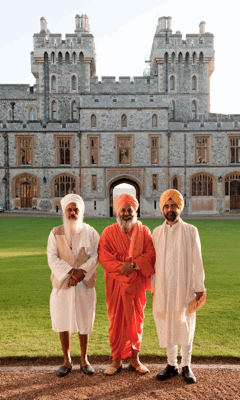
(ARC /Richard Stonehouse)
YOUNG: From the Jennifer and Ted Stanley Studios in Somerville, Massachusetts - this is Living on Earth. I’m Jeff Young. Next month, political leaders meet for an international summit in Copenhagen to try and meld science and policy on climate change. But a recent gathering of world dignitaries looked at global warming from another perspective – religion. Leaders of the world’s major faiths met at England’s Windsor castle for an event called “Many Heavens, One Earth”. They discussed climate action by churches, temples, mosques, and why protecting the planet is an article of faith.
[GOMAA: [ARABIC], TRANSLATOR: The Koran states “…do not cause corruption on the earth after it has been set in order…”; SAVAGE: In Jewish tradition, the big vision repeated thrice daily at the end of the traditional prayers is [HEBREW]. To heal and improve the world is the divine realm; THOMAS: Our Christian faith mandates that we honor the creation that God put under our charge; VYAS: Hindu scriptures are replete with spiritual and poetic references to Mother Earth, where the trees, the mountains, and the rocks become shrines.]
YOUNG: Martin Palmer is Secretary General at the Alliance of Religions and Conservation, which organized the event along with the UN Development Program. He joins us now from London. Mr. Palmer, welcome to Living on Earth.
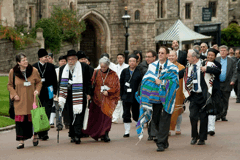
(ARC /Richard Stonehouse)
PALMER: Thank you, Jeff.
YOUNG: Now, tell us about some of those religious leaders we just heard from there.
PALMER: The first one was the Grand Mufti of Egypt. He has enormous spiritual and intellectual authority within Islam, and he was speaking on behalf of the Muslim seven-year plan – setting out to green the Hajj, make sure the printing of Korans (15 million a year) is done on recycled paper, and so forth.
He was followed by Nigel Savage, who is representing the Jewish seven-year plan. Their commitment is to cut meat eating in the Jewish community by 50 percent by 2015 and to also link synagogues to local farms.
He was then followed by the dramatic Bishop Thomas, who comes from the New Psalmist Baptist Church in Baltimore, USA, and their commitment involves a whole youth training program in environmental action and a whole program of empowerment of the poor and the dispossessed, so that they can actually become a voice and a force, themselves, to tackle environmental problems.
And then, the final speaker was Kusum Vyas, who represents the Hindu nine-year plan. They are building on the old Hindu tradition of vegetarianism, which we now appreciate as of huge ecological significance, and the Hindus are planning to develop their own environmental label, so that Hindus can buy ethically, environmentally, and faithfully.
YOUNG: How many faith groups, in all, were represented?

(ARC /Richard Stonehouse)
PALMER: We actually had somewhere in the region of 50 major faith traditions from around the world – it was a huge gathering and it was a gathering not to discuss what they might do, it was a gathering at which they launched their long-term plans to help save and protect the living planet.
YOUNG: So, this was not just a talk – they’re going to practice what they preach, so to speak?
PALMER: Very good, you’ve put it that way. We as our maxim for the whole program a Confuciusist maxim, actually, that we developed with the UNDP, our UN colleagues that, first of all, practice what you want to preach, and then only preach what you’re already doing. And so nobody came to this event unless they had developed systematic long-term plans which would embed environmental awareness, education, action, use of their investment portfolios, turning their lands to organic, developing forestry schemes for their forests for the major faiths.
YOUNG: And do you know, roughly, how many people those groups at the gathering represent?
PALMER: Before the event, we had 31 major commitments from faiths around the world, and the UN calculated that these schemes could affect the lives of potentially two billion people. However, we had left it open for the possibility of new partnerships, new groups that wished to say, we haven’t got a scheme yet, but within the next year we will have one, and we had 19 new schemes that came forward – ranging from the Russian Orthodox church, remember they own something in the region of 30 million hectares of land in Russia, most of it forest and farm land – and some 18 commitments from major secular organizations, including the UN, the World Bank, WWF, and so forth.
YOUNG: So, two billion plus people potentially influenced by what these religious leaders say they’re going to carry out here. We’re getting up close to a third of humanity here.

(ARC /Richard Stonehouse)
PALMER: That’s right. Well, bear in mind that 85 percent of the world professes a faith. And one of the problems for the environmental movement has been that it emerged, initially, out of the secular northwest Europe and it saw the world through its own eyes and assumed that everybody else considered that religion was, if not irrelevant, about as significant as if you liked and Indian take-away or a Chinese take-away.
And, because the UN said, you know, there is no way we are going to tackle climate change or any of the other major environmental problems unless we are in partnership with the major moral, spiritual forces of the world, who also happen to own eight percent of the habitable surface of the planet, are the third largest investing group in the world, have either run, founded or set up some role in over 50 percent of all schools, and publish more books per year than the whole of the rest of the publishing industry.
The question really is why on earth weren’t they working with us before? And I think we’ve turned a corner. There is now a worldwide recognition that the faiths should be invited to the table as equals of any other sector of civil society. And a very strong sense, I have to say, that as we head towards Copenhagen, the nation states are rapidly losing the credibility that they can actually do anything, and it may be civil society and not least of all religion, which will actually have to try and negotiated our way out of this mess.
YOUNG: You know, along those lines, one statement at the event caught my ear. This is a piece of tape from the Reverend Sally Bingham:

(ARC /Richard Stonehouse)
BINGHAM: I believe that religious leaders talking about environmental stewardship from the pulpit will have far more influence than a scientist or a politician on their own.
YOUNG: Mr. Palmer, you obviously think she’s right there. Why is it, though, that a religious messenger might be a better one on this issue than a scientist?
PALMER: Because people trust them. It’s as simple as that. Scientists are, on the whole, not very good communicators. There are one or two exceptions.
They are not very good at telling stories, and one of the points that came out time and time again in our work in developing for this is that nobody was ever moved to change the way they live by a pie chart, but they are moved by a story.
And in a sense, the environmental world has relied on science and facts, bald facts if I can put it that way, for the last 40 years and the end result is we’re in a worse case than we were 40 years ago.
Nobody actually changes what they do unless they are inspired, touched, given hope. And to some degree, what has happened has been that the environmental movement has tried to mimic the power of religion, and it has stolen from religion certain aspects. So, it’s stolen the notion of sin: if you get up in the morning and you put on the radio, no doubt to listen to this program, you make a cup of tea – or rather being in America you make a cup of coffee because, sadly, you don’t know how to make tea – you then drive to work and you switch on your computer. You committed, according to environmentalists, four sins.
YOUNG: Hmmm, carbon sinners.
PALMER: Carbon sinners. They are very good at making us feel guilty they’re very good at fear. The trouble is they’re not very good at hope, salvation, liberation, redemption, and they’re appallingly bad at celebrating.
YOUNG: Well, I got to say when you talk about climate change it’s hard to see cause for celebration in this. I mean it’s a pretty gloomy outlook.
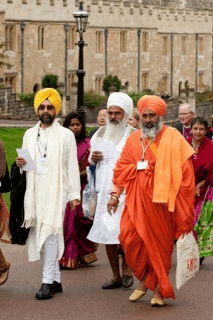
(ARC /Richard Stonehouse)
PALMER: Well, it is and it isn’t. You see, if there is nothing to celebrate, why would you bother? And the faiths are the oldest institutions in the world – they know more about how human psychology works than any other organization, which is why they’ve outlived every dynasty, every empire, they’ve outlived Communism pretty much, they’ve outlived the League of Nations, and as we gently point out to our colleagues in the UN, they will outlive the UN.
Now, how do they do this? They do this because they know that you can ask people to fast and you can ask them to repent, and then you feast. You have to fast and feast. If all you tell people they can do is fast, they give up. You’ve got to give people hope.
There’s a wonderful phrase in the psalms: without hope, people perish. And they perish because you cannot live with fear. Fear is disabling, it steals the energy from you. You’ve got to give people hope, not false hope, not say, oh don’t worry it’s all going to be fine it’s no problem at all.
But you got to say, look what is it that will make me as an Anglican do something with my church? What is that will make a Jew in New York take seriously what his or her Synagogue should do? What is that will make a Hindu in Fiji address the environmental issues in their own country?
And there is hope. There is still the possibility that we can turn the tide on climate change. We can’t stop some of it, but we can mitigate some of it. But there is also the belief that this world is not just material, which isn’t to say, don’t worry, you’ll be happy in heaven afterwards, but it is saying, you know, as Hamlet says to Horatio in the great play by Shakespeare: There are more things in heaven and earth than are thought of in your philosophy.
YOUNG: So, when environmentalists and scientists look at, say, these recent polling figures in the United States that show fewer people appear to be getting the message here, despite their efforts, you would say that’s because you guys don’t understand the power of the parable and the importance of inspiration?
PALMER: Precisely. We have been telling people that it’s hopeless for so long they’ve decided it’s not worth worrying about. Moreover, climate change is only a symptom; it’s not the problem. The problem, to use old-fashioned religious language, is sin, greed, and selfishness, and foolishness. That’s the problem, the fundamental problem is that we are out of kilter with our planet – we’re out of kilter with God, we’re out of kilter with our neighbors, and very often we’re out of kilter with ourselves.
And so, the solution is not to tackle climate change, per say, the solution is in fact to offer people a vision of living hopefully and living more simply, living more faithfully and doing so not as either victims or perpetrators, but perhaps, as heroes.
YOUNG: Martin Palmer is with the Alliance of Religions and Conservation. He’s telling us about the gathering of “Many Heavens, One Earth”. Thank you very much.
PALMER: Thank you.
Related links:
- Webcast of the event
- Click Here to Hear a Full Interview with Martin Palmer
[MUSIC: John Scofield “Walk With Me” from Piety Street (Emarcy Records 2009)]
YOUNG: Well, you can hear more of our interview on our website, LOE dot org.
[MUSIC]
YOUNG: Coming up: Saving the forest and the trees in the Pine Tree State. Keep listening to Living on Earth.
Climate Bill Numbers
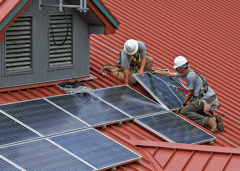
Workers install solar panels at a facility in Wayne National Forest. (Courtesy of: Wayne National Forest)
YOUNG: It’s Living on Earth, I’m Jeff Young. Now, get out your spreadsheets we’re going to talk about the dollars and cents of dealing with climate change. The bill before the US Senate could have major impacts on our economy, whether positive or negative depends on who’s talking. Industry groups tout studies warning of steep jobs losses due to higher energy prices. Environmental groups counter with analyses that should a bonanza of new, green jobs.
To put those predictions in context, we called on economists on either side of the debate. We start with University of Massachusetts Amherst Professor Robert Pollin. His Political Economy Research Institute produced a study that predicted one point seven million new, clean energy jobs. Mr. Pollin, how did you arrive at that figure?
POLLIN: Well, the basic factors generating the net expansion of jobs is very straight forward. There’s two considerations: one, in moving from a fossil fuel-based economy to a clean energy economy, we need to hire more people. There’s more people involved in building the clean energy economy as opposed to maintaining the fossil fuel economy – that’s number one; and number two is the economic activity that takes place in constructing a new clean energy economy is concentrated in the U.S., as opposed to spending a lot of our money on energy abroad as we do now, by importing oil.
YOUNG: So, the money spent is domestically spent, and therefore is going to have more cyclical spinoff effect on the economy.
POLLIN: We’ll have more cyclical spin off and more long-term spin off. The model that we have is a snapshot, it says in today’s economy if you take a million dollars and you take it out of the fossil fuel economy and put it into clean energy activities – in today’s economy – what would happen, and the results are straight forward, the results say that it’s more spending on jobs and more spending on the domestic economy. That it couldn’t be more simple.
YOUNG: So, what sort of assumptions go into your model? Assumptions about what our energy future will look like?
POLLIN: Well, 70 percent of the spending we’re assuming in clean energy is for energy efficiency. Every time you spend for energy efficiency you’re actually reducing greenhouse gas emissions and you’re actually lowering – not raising – you’re lowering energy costs because that’s the very definition of energy efficiency. If we can lower our home heating bills by making homes more energy efficient, we’re lowering energy costs, we’re reducing greenhouse gas emissions and we’re creating a lot of jobs.
YOUNG: I want to hear what you think of the analysis from the Congressional Budget Office. Here’s what the CBO director Douglas Elmendorf told a Senate panel last month:
ELMENDORF: Aggregate performance, the fact that jobs turn up somewhere else for some people, does not mean that there aren’t substantial costs born by people, communities, firms, and effected industries in effected areas.
YOUNG: So, what do you make of that, this CBO director saying there will be significant job losses here?
POLLIN: Absolutely, I couldn’t agree more. There’s three and a half million, more or less, people whose jobs are somehow connected right now with the fossil fuel sector of the economy. So, there’s millions of jobs, there’s billions of dollars, if we’re talking about transferring money out of that industry, of course there are going to be costs.
Now, given that, it’s very important that the Waxman-Markey bill that passed the House of Representatives and the equivalent measure that’s being considered now in the Senate includes quite considerable funds to support communities and workers that are going to have to go through a transition out of fossil fuels and into something else. Now, having said that while there are going to certainly be losses, the point that I’m making overall is that there is going to be a transition, but overall there’s going more employment in the end, and in the transition.
YOUNG: What advice do you have for us lay people as we listen to the debate around the climate bill? When we hear these competing studies, numbers about job losses, numbers about job gains – what should we be keeping in mind? What’s going to give us context to properly interpret this?
POLLIN: Well, first of all, lets keep in mind that the ultimate aim here, the first aim, is to address the potential ecological catastrophes of not reducing our greenhouse gas emissions.

Workers install solar panels at a facility in Wayne National Forest.(Courtesy of: Wayne National Forest)
YOUNG: In other words, the cost of doing nothing at all?
POLLIN: Yeah, we have to do this. So, given that then the question is how do we do that in the most beneficial way for the economy? And it turns out that this transition will move us toward an economy where we spend more money on jobs in the U.S. for working people in the U.S.
YOUNG: Economics Professor Robert Pollin. He says even the pessimistic studies still show no significant decline in economic growth in the long-term. But, David Montgomery is one of those pessimists, as Vice President of Charles River Associates, he’s done economic analyses of climate legislation for industry and business groups.
MONTGOMERY: When we looked at the climate bills, we found that they are likely to have a cost to the U.S. economy, that the cost could be substantial, in the range in 2020 between $600 per household and $1,600 per household, growing after that, but also that those costs are very uncertain.
YOUNG: And, did you look at job growth or job losses?
MONTGOMERY: We concluded that there would be a loss of about two million jobs, ten or 15 years into the program compared to what the economy would be performing at otherwise.
YOUNG: And, how is it that your study finds about two million jobs lost, when other folks who look at this find one point seven million jobs gained?
MONTGOMERY: In order to come up with the large numbers for net job creation, you have to assume that there is a huge pool of people out there who are capable and ready to work and just are missing jobs because of the kind of short-run contraction of the economy. None of these long-term investments that energy bill would create are going to happen quickly enough to deal with the people who are out of work today. They are going to be happening, as usually happens with stimulus, fiscal stimulus, after the economy has gotten back to close to full employment.
YOUNG: So, you don’t see the possibility that after the jobs are lost in, lets say the fossil fuel dependent industries, that there would be a net gain overall? You don’t see that happening?
MONTGOMERY: No. Ultimately, the economy will make a transition to a different structure of employment with lower wages than there would have been otherwise and with opportunities for people to get back to work, but even after that transition they will be earning lower incomes than they were to begin with. And there will not be more jobs, there will be fewer jobs.
YOUNG: What about this notion that if we switch to domestic sources of cleaner energy, then we’ll be sending less of our money overseas to import other forms of fossil fuel energy?
MONTGOMERY: That’s absolutely correct. But, if all we’re doing is substituting more expensive domestic energy for cheaper imported energy we don’t end up ahead.
YOUNG: So, another big variable here is this notion of carbon offsets – that instead of reducing emissions, companies can pay someone else to do some forestry or agriculture that’s going to keep carbon locked up. How big a factor is that in determining the cost of the bill?
MONTGOMERY: It’s huge. Our estimates and those of the Environmental Protection Agency estimate that about half of the emission reductions will come from offsets. So, some of them in the United States would come from conservation practices in agriculture, or growing trees, which sequester carbon. A lot of them would be coming from overseas, again mostly from rewarding countries for reducing the rate at which they are basically tearing down their tropical forests. If you assume, as we did, that all of the offsets actually materialize, you get a price of carbon around $20 a ton in 2020. If you assume that just none of the international offsets materialize – and there are good reasons for thinking they might not – the cost doubles.
YOUNG: So, more readily available offsets, pretty much lower cost; tougher offsets, higher cost?
MONTGOMERY: Yes.
YOUNG: I’m wondering, have you given any thought to the cost of inaction? If we do not manage to come up with some way to address greenhouse gasses – what’s the cost of that?
MONTGOMERY: I’ve given it a great deal of thought, and I think we really need to focus on what inaction means. This is gonna cost us something – is it worth what it’s gonna cost, how much do we want to do in order to gain the benefits from doing something?
YOUNG: David Montgomery is Vice President of Charles River Associates. Thanks very much for your time.
MONTGOMERY: Thank you, it’s good to talk to you.
YOUNG: Charles River Associates has come under fire for exaggerating costs of climate legislation. Reports showing large green job growth, like Robert Pollin’s draw criticism for an oversimplified economic model. But these economists did reach one interesting area of agreement. First, David Montgomery:
MONTGOMERY: The fact is that what a cap and trade bill is going to costs us is something that policymakers cannot know when they vote for it. Because it all depends on future developments in technology, on future developments in the economy, on what other countries decide to do, and there is no way we can predict all of those things.
YOUNG: And, here’s Robert Pollin:
POLLIN: Nobody forecasted this recession, even after the recession had already started the best econometric models still weren’t even forecasting a recession while we were in the recession. So, that shows you that forecasting models have got a long way to go before they can even be as good as forecasting the weather, for example.
YOUNG: So, no matter how many economic projections lawmakers get, the will eventually have to decide climate change policy in the face of uncertainty. That, at least, is certain.
Related links:
- The Economic Benefits of Investing in Clean Energy, a PERI publication
- Impact on the Economy of the American Clean Energy and Security Act of 2009, a CRA publication
[Jeremy Udden “Plainville” from Plainville (Fresh Sound New Talent 2009)]
Downeast Conservation
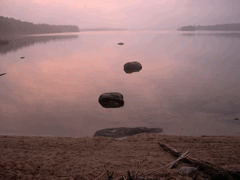
The Downeast Lakes Land Trust protects more than 60 lakes and ponds and 400 miles of lake shore. (Photo: Laurie Sanders)
YOUNG: Anthropologist Margaret Mead famously wrote, “Never doubt that a small group of thoughtful, committed citizens can change the world. Indeed, it is the only thing that ever has.”
Well, here’s a story that illustrates Mead’s words. From the eastern most part of Maine, not far from the Canadian border, a landscape of lakes and forests. Laurie Sanders took a trip there and has our story.
SANDERS: The town of Grand Lake Stream is tiny. Only120 full-time residents. But since the 1860s, it’s had a reputation as a premiere fishing destination.
[Paddling]
The village is situated on West Grand Lake, which, with 14,000 acres, supports bass, lake trout and one of Maine’s only native populations of land-locked salmon. Steve Keith is an avid fisherman. We’re about a mile uplake from town. And from this point, we can’t see a single camp. Or boat. Or person. Just sky. And forest. And water.
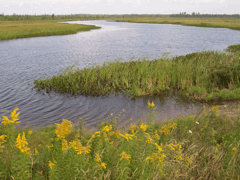
Ponds and 400 miles of lake shore. (Photo: Laurie Sanders)
KEITH: If you go from this place, eastern Maine to Florida, there’s nothing like it in between. This is in many ways unchanged from when the Abenaki and the Passamoquaddy tribe, who are still here and local, plied these waters in birch bark canoes. Their ancestors would look at it, and see that it’s the same.
[Paddling]
SANDERS: And thanks to the dedication and tenacity of a small group of people, this place will look this way for generations to come.
UPHAM: We had no idea what we were getting ourselves into. You know, it seemed like we had to do something, and when we started talking to people. Everybody said go for it.
SANDERS: Jimmie Upham is a former schoolteacher, and one of six locals who, came up with an audacious plan: to protect 342,000 acres surrounding the community of Grand Lake Stream. That means forests, wetlands, lakes, the all of it.
It all began ten years ago, when Georgia Pacific, one of the nation’s largest timber companies, sold 450,000 acres in and around Grand Lake Stream to an investment interest, with Wagner Timberlands hired to manage the property. At first, no one was concerned. Big timber companies had owned land around here for decades. But within a year, that sentiment changed – says fishing guide and logger Louie Cataldo. He says Georgia Pacific had already cut the forest pretty hard, so the townspeople assumed the new owners would wait a while for the trees to grow bigger:
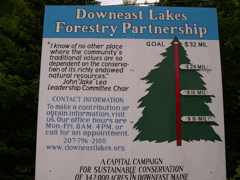
(Photo: Laurie Sanders)
CATALDO: But what they did, they bought the land they went around and really cut everything that was left, that was saleable. And we could see that happening, and it kinda upset because we really care about these woods. It’s important to our lifestyle.
SANDERS: The local economy here depends almost entirely on healthy forests and pristine rivers and lakes. Cataldo says with the extensive cutting they observed, these qualities were being jeopardized. Even worse, Steve Keith says there was a real threat that the timber company would start dividing up the land and selling it off as house lots.
KEITH: What we were concerned about was that all the shoreline would be subdivided and developed, and it would ruin the character of the area. If you want to experience that, you just go south of Bangor to any of the lakes in Maine or New Hampshire that are ringed with camps. The water quality goes down, the noise increases, and you don’t have an experience in nature like you can here.
SANDERS: Faced with this, a group of people came together. It included loggers and fishing guides, lodge owners and mill workers, lawyers and former business executives. It also included locals, like Cataldo, and summer people, like Keith. Their first idea was to buy a buffer around West Grand Lake, but as they talked to more people and other organizations, the scope of their project grew bigger. And bigger.
After two years, they negotiated with the timber company to buy 27,000 acres as a community forest and purchase the development rights on another 312,000 acres. But there was the price: $32 million dollars. And, a fundraising expert had told them the most they could hope to raise was two million. Again Jimmie Upham.

The Downeast Lakes Land Trust protects more than 60 lakes and ponds and 400 miles of lake shore. (Photo: Laurie Sanders)
UPHAM: The numbers were numbers that none of us had ever dealt with before. And part of it, I don’t think we had any concept of what two million was, and if we didn’t know what two million was than going from two to 32 didn’t matter a hill of beans. [laughs].
SANDERS: And Cataldo says, by then, people were fired up, and the group felt an obligation to try.
CATALDO: It was terribly frightening because we surely didn’t want to fail. It was just terrifying to think that we had to raise that kind of money, but we kept pushing on, and a few key people told us that we could do it, and of course, them’s the ones we wanted to listen to.
SANDERS: To make it happen, the group formed the Downeast Lakes Land Trust, hired Steve Keith as the executive director, and pulled in a key partner – the New England Forestry Foundation, an organization with a similar commitment to sustainable forestry, recreation and wildlife habitat protection. And, it had extensive fundraising experience. Over the next several years, the partnership hosted events, led field walks, talked to prospective donors. And donations came in, ranging in size from a single dollar to a seven million dollar gift from a private foundation. In 2005, they signed the papers on the land, but Keith says they were still short of their fundraising goal. And that’s when the New England Forestry Foundation did something creative and risky.
KEITH: We still needed six million dollars, and in order to do that the New England Forestry Foundation put up as collateral a forest they owned in eastern Massachusetts, and then we spent another two years raising that six million dollars. That may have been the most difficult part because raising money after you’ve closed on the property is extremely hard. People aren’t motivated to give you money at that point.
SANDERS: But last year, the Downeast Lakes Land Trust and New England Forestry Foundation finished raising all 32 million dollars. And with that, they protected more than 60 lakes and ponds, 400 miles of lakeshore, and some of the best loon habitat in the state of Maine. They also kept the land on the tax rolls, with most of it in working forest. And Louie Cataldo says they also assured public access for recreation to all of it. Anyone can go there, to hunt, fish, hike, or canoe.
CATALDO: When you ride up the lake and look at what we’ve protected, and knowing it’s going to be like that forever, it does make you feel real good. And I feel lucky that I got to be part of it.
SANDERS: But they’re not quite done. Earlier this year, the Land Trust began working to protect the last big parcel. A 21,000-acre block along West Grand Lake with 15 miles of lakeshore.
CATALDO: We can’t rest. If we miss a deal like this, it’ll never come back to us.
SANDERS: And the asking price? Just 24 million dollars.
For Living on Earth, I’m Laurie Sanders.
Related links:
- Downeast Lakes Land Trust
- To hear more of Laurie Sanders' work, click here
[Patricia Barber: “Icarus” from Mythologies (Blue Note records 2006)]
Chemicals and Cholesterol
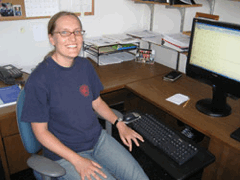
Jessica Nelson MPH, lead study author and researcher at the Boston University School of Public Health
YOUNG: It's Living on Earth, I'm Jeff Young. Two new studies are raising concerns about some chemicals cholesterol. Polyfluoroalkyl chemicals or PFCs have a long history in common consumer products like Teflon, stain-resistant fabrics and even some food wrappers. PFCs made those products non-stick, but the chemicals do stick around in our bodies, and it could be raising cholesterol. Health researcher Jessica Nelson conducted one of those studies at Boston University’s School of Public Health. Ms. Nelson, welcome to the program.
NELSON: Thank you, glad to be here.
YOUNG: Well, tell me about your results here. What did you learn about the link between these chemicals and cholesterol?
NELSON: Our study found that higher levels in blood of three of these PFC chemicals was associated with higher levels of bad cholesterol. And this was in a sample of the general U.S. populations.
YOUNG: So, this is not people whose drinking water was contaminated or who are working with these chemicals? This is me, you, everybody else?
NELSON: That’s right. And so the CDC conducts this survey, including testing people’s blood for PFC and other chemicals. So we were considering a population of the general U.S. population. Not workers who are highly exposed, not communities who are highly exposed from drinking water or other sources. And, virtually everyone tested we can detect these chemicals in their blood.
YOUNG: How are we exposed?
NELSON: Unfortunately, more research needs to be done. We really don’t understand very well the specific ways people are exposed. The likely pathways are through ingestion of food and drinking water. But, possibly also ingestion and inhalation of dust and air in homes. And basically products where chemicals are used to make them more stain, oil, water, grease-resistant. So, possible products are things like pizza boxes, takeout food wrappers, carpet treatments, textile treatments – it’s a pretty broad category of products that a lot of us encounter everyday.
YOUNG: So, generally speaking, what do these chemicals do when they get in our bodies? As I understand it, a lot of chemicals of concern build up in our fat deposits. But, that’s not necessarily the case with these, right?
NELSON: That’s true; they’re considered persistent chemicals but they aren’t lipophilic or building up in fat deposits like other ones you hear about like PCBs or dioxin. It looks like instead that they actually bind to proteins, so they might be binding to proteins in our blood, proteins in our liver, proteins in other tissues, and that’s why they’re sort of in our bodies for a number of years.

Jessica Nelson MPH, lead study author and researcher at the Boston University School of Public Health
YOUNG: Well, give me an idea of the persistence, either in the environment or in our bodies.
NELSON: In the bodies, they have a half lives on the order of five years, so within five years time half of the chemical will excreted from the body. That’s a fairly persistent chemical, sort of compared to some other chemicals that we’re exposed to.
YOUNG: Now, this is just one of many red flags that researchers have raised about the potential health effects of these chemicals. And there were so many red flags, in fact, that some of the major users – DuPont, 3M, other companies – entered into this voluntary agreement with the U.S. Environmental Protection Agency to phase out the use of some of these. Does that mean that we’re not going to see these chemicals around anymore?
NELSON: Well, we have seen that blood concentrations are decreasing. But it doesn’t mean that we’re not going to see them anymore. First of all, as we’ve talked about, they’re persistent, so they stick around in our bodies for years. And, they also are persistent in the environment, so just because we stop them today doesn’t mean that they’re going to go away in the environment. There’s also a possibility that some other PFC chemicals that haven’t been phased out may actually break down into PFAS and PFOA– those are the two chemical and chemistries that are being phased out.
But not all of them have been eliminated, so one of the chemicals in our study that we did find this association with, PFNA, has not been phased out. And, in fact, we know that blood concentrations in people seem to be increasing for this chemical rather than decreasing.
YOUNG: So, what’s the potential health implication for me, you, for every other person who presumably has some of this stuff hitching a ride in our blood, in our livers – if it is indeed contributing to higher cholesterol?
NELSON: It’s a very good, and the most important question. One caveat that I want to give is that this is an exploratory study and there definitely are limitations to what we can say about it. It was an association study, so we really don’t feel we can say it’s a cause and effect relationship at this point. We know enough to know that we should be concerned and that we should aggressively pursue future research. But, unfortunately, it’s too early to sort of make that causal connection about your cholesterol levels or my cholesterol levels at this point.
YOUNG: Now, we reported back in 2006 on the settlement of this class action lawsuit against Dupont where folks in the area of the chemical plant were exposed to some of these chemicals via their drinking water. And the settlement was unique in that it set up this massive health-screening program. Is that health-screening effort, is that beginning to show us any results?
NELSON: So their population was highly exposed to one of the PFCs, PFOA, through their drinking water. So, the levels of PFOA are much higher than in our study. The levels of the other PFCs are similar. And from what I’ve seen they have consistent findings with what we saw. Namely, that higher levels of these PFCs are associated with higher total cholesterol and bad cholesterol.
YOUNG: And again, not a smoking gun – they can’t say conclusively, as you can’t say conclusively, but one study after another appears to be pointing in the same direction.
NELSON: That’s true, the same picture is emerging from these studies, but we haven’t quite addressed this fundamental limitation of a lot of the studies yet. But, it doesn't make sense to me that we should be exposing people to these PFC chemicals until we know they’re safe. And to me, from the research, I have seen this isn’t proven.
YOUNG: Jessica Nelson with the Boston University School of Public Health, thanks for coming by.
NELSON: Thank you.
Related link:
For a copy of the study, click here
[Quantic “Angels and Albatrosses from Mishaps Happening (Ubiquity 2004)]
Squatting the Berlin Wall
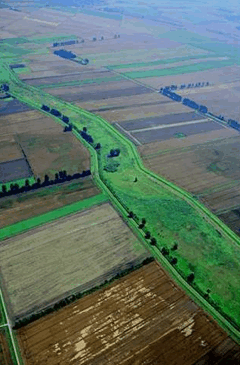
The Iron Curtain left behind an accidental strip of wilderness between Eastern and Western Europe. (photo: IUCN)
YOUNG: Twenty years ago this week the Berlin wall was coming down – reuniting Eastern and Western Germans after almost 30 years. German Chancellor Angela Merkel marked the anniversary with a speech to the U.S. Congress. Merkel urged action to make a climate change agreement at Copenhagen possible. She called inaction another wall that must be brought down.
MERKEL: Once we in Europe and America show ourselves ready to adopt binding agreements we will also be able to persuade China and India to join in. And then in Copenhagen we shall be able to overcome this wall separating the present from the future in the interest of our children and grandchildren and in the interest of sustainable development all over the world. (APPLAUSE)
YOUNG: Today, parts of the former no man’s land along the iron curtain have come back to life in unexpected ways. Ashley Ahearn visited one community, nestled into the former militarized zone of the Berlin Wall, where people are redefining sustainable urban living.
[BOB MARLEY MUSIC PLAYING IN BACKGROUND, PEOPLE TALKING]
AHEARN: If you walk the former path of the Berlin Wall south from the Brandenburg Gate, you’ll come across a gravel footpath on the banks of the Landwehr canal.
Pumping music will lead you under a bridge and around a wooded corner and you’ll find, tucked in amongst lush greenery, the squatter community of Lohmuhle. But it’s not just any squatter community.
EWING: I think squatting always has been, the aspect of taking care of the place and not just going in there and say okay, we’ll be here for a bit until the roof comes down and then we’ll squat something else.
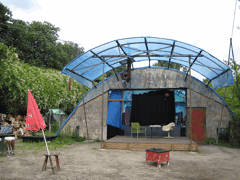
The stage in the center of the Lohmule trailer community in Berlin is a forum for education about sustainable low impact urban living. (photo: Ashley Ahearn)
AHEARN: Piers Ewing stands near a large dome-shaped structure made of plywood and particleboard. Two old deck chairs sit on a small stage. Behind them a bedraggled black theater curtain shields the entrance to the building. Off to the right of the stage is a makeshift bar. It’s made of particleboard decked with palm leaves and thatched reeds, Caribbean-style. A DJ spins records as Berliners talk and laugh in battered lawn chairs nearby. A couple of kids play in the grass.
[MUSIC FADES UP AGAIN, KIDS TALKING OVER IT]
EWING: It used to be a greenhouse in its former life and was built into a multi-use sort of stage and café building. So we are one of the few trailer parks that actually do things all year through.
AHEARN: By “doing things”, Piers means the public music, theater and education projects that take place on the old greenhouse-turned stage behind him. This community is more than a residential trailer park.
Since 1991 the squatters of Lohmule have worked to bring this dead strip along the Berlin Wall back to life. The city of Berlin has granted the squatters a permit to stay here because they are improving the landscape while educating the public about low-impact living. Piers lives here with 18 other people. They work as artists, teachers, shopkeepers, bike messengers and even clowns. Everyone uses an outhouse, where they rely on microorganisms to reduce the smell and help break down the waste.
EWING: No one knows what they are actually doing but apparently they are doing a good job.

The Iron Curtain left behind an accidental strip of wilderness between Eastern and Western Europe. (photo: IUCN)
AHEARN: The squatters carry water in buckets from the nearby canal to water their vegetable garden, which is tucked in amongst the 15 or so trailers out behind the stage area. Piers has installed solar panels on most of the trailers, making Lohmule almost completely energy independent. They power the stage and café area with a generator but there are plans to get a windmill installed soon. Anna Grichting is an architect who has been studying planning and sustainable development in Berlin since the wall came down.
GRICHTING: This space used to be totally barren sand with weed killers and now nature has reclaimed this space and what their experiment is to cooperate with nature.
AHEARN: Grichting studies boundary areas all over the world, focusing mainly on the demilitarized zone in Korea, the Green Line in Cyprus and the Berlin Wall. She sees this community as a prime example of how people repurpose the no man’s lands created by international conflict.
GRICHTING: It’s interesting because it’s a laboratory of ecological planning in these in between spaces. And I think it’s not only from the nature but also these new communities or new ways of living that emerge from these spaces.
AHEARN: Piers Ewing doesn’t see himself as a lab rat, or even an ecological planner. But he agrees that without the Berlin Wall, there could never have been a place like Lohmuhle. In the chaos that followed the wall coming down, the government didn’t have the resources to squelch the creative energy that spawned this community.
EWING: With the fall of the wall there was so much space and even if they didn’t like it they just couldn’t keep up with like getting everything paved and building fancy new places. It just couldn’t keep up so it was pretty easy to get things going and get a long-term perspective. Yeah it’s getting harder but it’s still Berlin and it’s not London or Paris or someplace like this.
AHEARN: For Ewing, Lohmuhle is a patch of wildness in the urban environment, but it also represents a unique opportunity to live life a little bit on the wild side, outside of the rat race. He studied physics in college but for now Piers is happy teaching drums in the local community, and working on his own musical projects.
EWING: If I put it on a financial scale, but I don’t want to, I would be better off working a bit more and moving into a flat. I would have more time or more money in the end, but if I work on the project, I decide what I do, and not my boss.

Piers Ewing has lived in Lohmule for about two years now, and installed solar panels on almost every trailer. The community is almost energy independent. (photo: Ashley Ahearn)
AHEARN: Ewing’s too young to really remember what life was like when his country was divided by the wall and the Cold War, but whether he understands it or not, he’s part of the healing process for the city of Berlin. Among all the grand public buildings that have sprung up where the wall once split the city – Lohmuhle represents an alternative approach to rebuilding after troubled times, and a new take on modern urban life.
YOUNG: Ashley Ahearn’s reporting was made possible by a grant from the Institute for Human Sciences in Vienna. Ashley spent the summer traveling sections of the former iron curtain, now she’s back in the states and with us in the studio. Welcome back, Ashley.
AHEARN: Thank you, Jeff.
YOUNG: You know, I’m amazed by these examples you found. I guess you might call these accidental conservation areas all along the old iron curtain?
AHEARN: They really were – they’re not planned. It was a complete function of the dark history of the period. As one professor explained it me, you know, all walls represent policy failed, and this was really an instance where nature profited from that failure in policy. This was unused land.
YOUNG: Went into the vacuum, if you will.
AHEARN: Yeah.
YOUNG: And in some spots, it’s almost like the no-mans-land there of the iron curtain became kind of the last hedgerow for animals seeking shelter from the development on either side.
AHEARN: Yeah, it was an idea that I think a lot of Americans – or, at least I had a really hard time wrapping my head around – that people really couldn’t travel to the other side of this curtain, it really was a curtain of iron. It was about a 50 meter to 100 meter wide militarized buffer zone that people weren’t allowed to pass. It had guard towers, watchdogs, land mines – I mean, it was a really – they weren’t messing around.
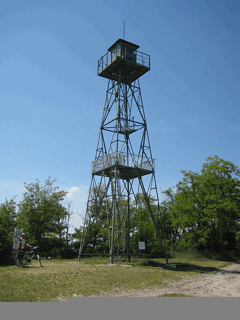
Towers that once served as vantage points from which to shoot refugees from Eastern to Western Europe now serve as bird observation towers in Neusiedler Seewinkel Park on the border between Austria and Hungary. (photo: Ashley Ahearn)
YOUNG: Well, tell me about some of the places and people you visited along the way? Tell me about Kai Frobel – he sounds interesting.
AHEARN: [laughs] Yeah, Kai Frobel’s really an amazing man. I guess I describe him to people as a cross between the Dr. Seuss character the Lorax and David the gnome. He’s just a very, very committed birder, and he’s been watching birds since well before the iron curtain came down. He grew up in a little town in northeastern Bavaria, right on the iron curtain; you could see it from his village.
And he spent his days, his afternoons, or early mornings, as it were, with binoculars walking along the militarized border. And the border police came to know him. However, the East Germans had a file about an inch thick on him because they thought he was a spy. Here he is, he’s out here with his binoculars and his little green jacket, camouflage gear, the whole deal.
YOUNG: Sure you’re looking at bird, buddy…
AHEARN: [laughs] Yeah, right. But, Kai, he really was. He was just in it for the birds. He cared really deeply, he was counting populations and really figuring out that they were taking refuge in this place that was surrounded by wheat fields on either side, so it was important habitat. And he’s the one who ended up starting the greenbelt movement. He realized what he was seeing in his outside, his own little village, was happening all up and down the iron curtain, and this was a huge opportunity for conservation.
YOUNG: Wow.
AHEARN: Yeah, he is such an unassuming man, but he held a small, informal meeting right in 1989 after wall came down, and invited some friends from East Germany and West Germany, trying to bring these people together – 200 people showed up. And ever since then this movement has just taken off.
YOUNG: What do they think might become of this? Are they going to be able to link up sections along the old iron curtain?
AHEARN: They’re kind of looking at it not as creating a new, green curtain – that’s not the goal, and a lot of people are nervous about that, they don’t want to see this blocked off. They don’t want a new division from eastern and western Europe. Kai Frobel talks about it as a green necklace, really, where you were given this wonderful opportunity with these chunks of green spaces along the former iron curtain. Why not try to create almost a very thin Appalachian Trail type idea, that would connect these chunks, like jewels in a necklace.
YOUNG: And in some places it really is taking off, the Harz National Park in Germany you visited there. Wolves are actually making a comeback.
AHEARN: Yeah. This is an amazing place; it’s kind of north-central Germany, mountainous area – well, not big mountains, but a really beautiful green patch in a pretty developed part of Germany. And Goethe made this place famous when he wrote about Walpurgisnacht, where all the riches come from all around the world and they gather in this one mountain, the Brokken, and they have a celebration with the Devil. And it was left wild, nobody was using this space, nobody was allowed to use this space. And so, now that the wall of the iron curtain has come down, you’re left with this green space and the wolves are moving in from Poland, from eastern Germany, and starting to kind of populate what they’re trying to keep as a green space now. And of course it’s raising all sorts of controversy, just like it does here in the U.S.
YOUNG: You also visited Lake Neusiedl, this is on the border between Austria and Hungary. And I just love the sort of swords into plow shares imagery here, where the old guard watchtower – people now use it for bird watching.
AHEARN: Yes, Alois Lang, who is a coordinator for the park took me up on one of these things with all my recording equipment and it was a very, very nerve-racking thing, not being a big fan of heights myself. But these towers, really, I mean you can see exactly why they had them in. The lake is only about three feet deep, it’s surrounded by reed beds, which makes it a great spot for birds, that use it as a migratory – major migratory stopover – from Africa to the Arctic. But it was also a great way to escape from Hungary into Austria, and so you have people trying to come across this very shallow lake, and people from these guard towers would shoot them.
YOUNG: Do people visiting these places for the great nature – do they still get a sense of this very dark episode in human history, even though they’re there for the natural history?
AHEARN: I think people only want a certain dose of dark history, I think when you’re on a family vacation you don’t want to be talking about people getting shot from guard towers, but I think for Austrians, for Germans, this is a really important part of their history. And so being able to put a green light on it, a sort happier light on it, is a great way to kind of have your spoonful of sugar with your historical medicine, as it were.
YOUNG: Ashley Ahearn telling us about nature’s comeback along the old iron curtain. Thanks a lot, Ashley.
AHEARN: Great to be here, Jeff.
Related link:
Ashley Ahearn's Web Page
YOUNG: Living on Earth is produced by the World Media Foundation. Our crew includes Bobby Bascomb, Eileen Bolinsky, Bruce Gellerman, Annie Glausser, Ingrid Lobet, Helen Palmer, Jessica Ilyse Smith, Ike Sriskanderajah, and Mitra Taj, with help from Sarah Calkins, Marilyn Govoni and Sammy Souza. Our interns are Quincy Campbell and Nirja Parekh. Jeff Turton is our technical director. Alison Lirish Dean composed our themes. Steve Curwood is our executive producer. You can find us anytime at LOE dot org. I’m Jeff Young. Thanks for listening.
Funding for Living on Earth comes from the National Science Foundation, supporting coverage of emerging science, and Stonyfield Farm: organic yogurt and smoothies. Stonyfield pays its farmers not to use artificial growth hormones on their cows. Details at stonyfield.com.
Support also comes from you our listeners, the Ford Foundation, the Town Creek Foundation, the Oak Foundation supporting coverage of climate change and marine issues; the Skoll Foundation, supporting social entrepreneurs around the world – uncommon heroes dedicated to the common good. Learn more at skoll.org; and Pax World Mutual Funds: socially and environmentally sustainable investing. Pax World: for tomorrow. On the web at paxworld.com.
Living on Earth wants to hear from you!
Living on Earth
62 Calef Highway, Suite 212
Lee, NH 03861
Telephone: 617-287-4121
E-mail: comments@loe.org
Newsletter [Click here]
Donate to Living on Earth!
Living on Earth is an independent media program and relies entirely on contributions from listeners and institutions supporting public service. Please donate now to preserve an independent environmental voice.
NewsletterLiving on Earth offers a weekly delivery of the show's rundown to your mailbox. Sign up for our newsletter today!
 Sailors For The Sea: Be the change you want to sea.
Sailors For The Sea: Be the change you want to sea.
 The Grantham Foundation for the Protection of the Environment: Committed to protecting and improving the health of the global environment.
The Grantham Foundation for the Protection of the Environment: Committed to protecting and improving the health of the global environment.
 Contribute to Living on Earth and receive, as our gift to you, an archival print of one of Mark Seth Lender's extraordinary wildlife photographs. Follow the link to see Mark's current collection of photographs.
Contribute to Living on Earth and receive, as our gift to you, an archival print of one of Mark Seth Lender's extraordinary wildlife photographs. Follow the link to see Mark's current collection of photographs.
 Buy a signed copy of Mark Seth Lender's book Smeagull the Seagull & support Living on Earth
Buy a signed copy of Mark Seth Lender's book Smeagull the Seagull & support Living on Earth

